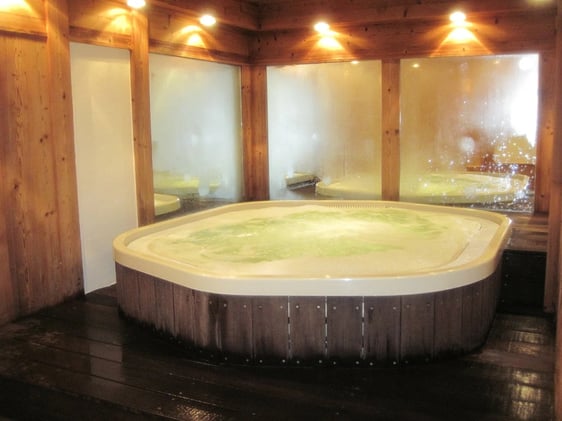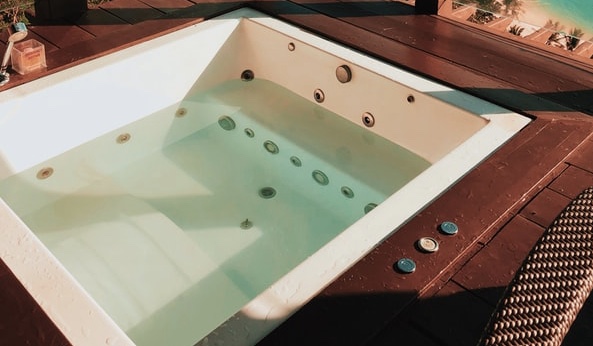How to Lower Alkalinity in Your Hot Tub or Spa
Stressful day? Yeah, we’ve been there, too.
In fact, that’s probably why you got a hot tub in the first place - they’re the perfect place to unwind. Those warm bubbles can make all those worries just float away.
The last thing you need is for your haven to leave you with itchy eyes and irritated skin.
That’s why hot tub maintenance is so crucial.
There are many elements to caring for your hot tub. This guide takes a deep dive into one aspect of balancing the chemicals within your spa, how to lower the Alkalinity in your hot tub.
- What is Alkalinity?
- Why is High AlKalinity Bad for Your Hot Tub?
- How to Lower Alkalinity in Your Hot Tub or Spa
- How Often Should I Check Alkalinity levels?
What is Alkalinity?
If you’re chemistry savvy, then you know that Alkalinity, aka Total Alkalinity (TA), is the measure of water’s ability to neutralize a change in pH.
For the rest of us, this means that the Alkalinity of your spa keeps the water from growing too acidic, which would damage your skin and the spa itself.
Why is High AlKalinity Bad for Your Hot Tub?
While Alkalinity at any extreme isn’t great for your hot tub or spa. Low Alkalinity will indeed result in nearly constant fluctuation of the pH levels, but high Alkalinity can be just as troublesome.
According to Hunker.com, the ideal range of your Alkalinity should be between 80ppm -120ppm (Parts Per Million).
If the Alkalinity in your hot tub is too high, the resulting pH imbalance can lead to increased calcium in the water. This can lead to scaling, clogging the inside of pipes and filters, as well as corroding the walls of the spa.
This build-up will hinder the performance of your spa, if not outright damaging the equipment, and calcium flakes can turn the water a cloudy green (yuck).
If that doesn’t deter you from dipping into your pond water, a chemical imbalance can reduce the effectiveness of any sanitizers you’re using, like chlorine or bromine. This can lead to itchy skin and irritated eyes, which is both gross and uncomfortable.

How to Lower Alkalinity in Your Hot Tub or Spa
Lowering the Alkalinity is a gradual trial and error process. To make your spa safe for lounging as quickly as possible, follow these simple steps.
- Test Your Hot Tub’s Total Alkalinity
- Use Sodium Bisulfate to Lower the Hot Tub’s Alkalinity
- Circulate the Spa Water
- Retest the Hot Tub Water
Step 1 - Test Your Hot Tub’s Total Alkalinity
Using a test strip from your test kit, test the Total Alkalinity of your hot tub.
Submerge the test strip several inches below the water. When you pull out the strip, it will change colors.
Compare the strip to the color chart from your test kit. The results will indicate if you need to raise or lower the hot tub’s Alkalinity.
If the test strip tells you that your hot tub’s Alkalinity is above 120ppm, then you’ll know you need to lower it.
Step 2 - Use Sodium Bisulfate to Lower the Hot Tub’s Alkalinity
Ideally, the Alkalinity of your hot tub should be between 80ppm - 120ppm — 100ppm is an ideal level to shoot for. The easiest way to drop your Alkalinity level is by adding sodium bisulfate to the tub.
That said, you can’t just toss a handful of chemicals into the water and call it a day. You need to calculate the required amount of sodium bisulfate from the volume of water in your spa and the current TA.
If you just groaned because math isn’t really your thing, don’t worry. The process is simple.
Sunrise specialty suggests that “to lower the Alkalinity of 1,000 gallons of water by 10ppm, you need to add 3.5oz of sodium bisulfate.”
So, let's say you have a six-person hot tub that holds around 500 gallons. To lower the Alkalinity by 10ppm you’d need half the sodium bisulfate - 1.75oz. Of course, a smaller two-person hot tub could require much less.
Once you’ve calculated the needed sodium bisulfate, sprinkle the powder into the water near the edges of the hot tub. Pay special attention to the deep end of your spa if it has one.
Step 3 - Circulate the Spa Water
Now that you’ve added the sodium bisulfate to the water, start the pumps in your spa. Let them run for 10 - 20 minutes before turning it off.
This will help circulate the powder throughout your hot tub to ensure that the Alkalinity lowers evenly and reaches any potential build up in your equipment.
Step 4 - Retest the Hot Tub Water
Retesting the water in your hot tub after you’ve made adjustments is a simple process, but can be time-consuming.
After circulating the sodium bisulfate, leave the tub uncovered for an hour or so and then test the water again. If you still need to lower the Alkalinity further, simply repeat the steps above.
Once you reach an Alkalinity level between 80ppm and 100ppm, leave the tub to rest overnight, and then test it again the following day. If the Alkalinity still isn't at the correct level, break out the sodium bisulfate and give it another go.
If you need any additional help, check out this video by Sundance Spa:
How Often Should I Check Alkalinity levels?
Just because you’ve finally lowered the Alkalinity in your hot tub or spa and balanced the pH, you’re not done for the season.
To keep your sanctuary relaxing and clean, test the Alkalinity in your spa once or twice a week. Not only will this keep any calcium build-up from sneaking up on you, but it will also make it easier to sanitize your hot tub and keep it clean.
A hot tub is a big investment, both financially and for your mental health. Proper chemical maintenance will ensure you and your family can enjoy it for years to come.
While you're Waiting for the Alkalinity to Lower
While you’re waiting for your hot tub to settle, leave a comment letting us know if there’s anything we missed.
We want this to be an evolving resource, and any questions you have will help us craft more helpful content for you.
Now, go relax. You’ve earned it!

